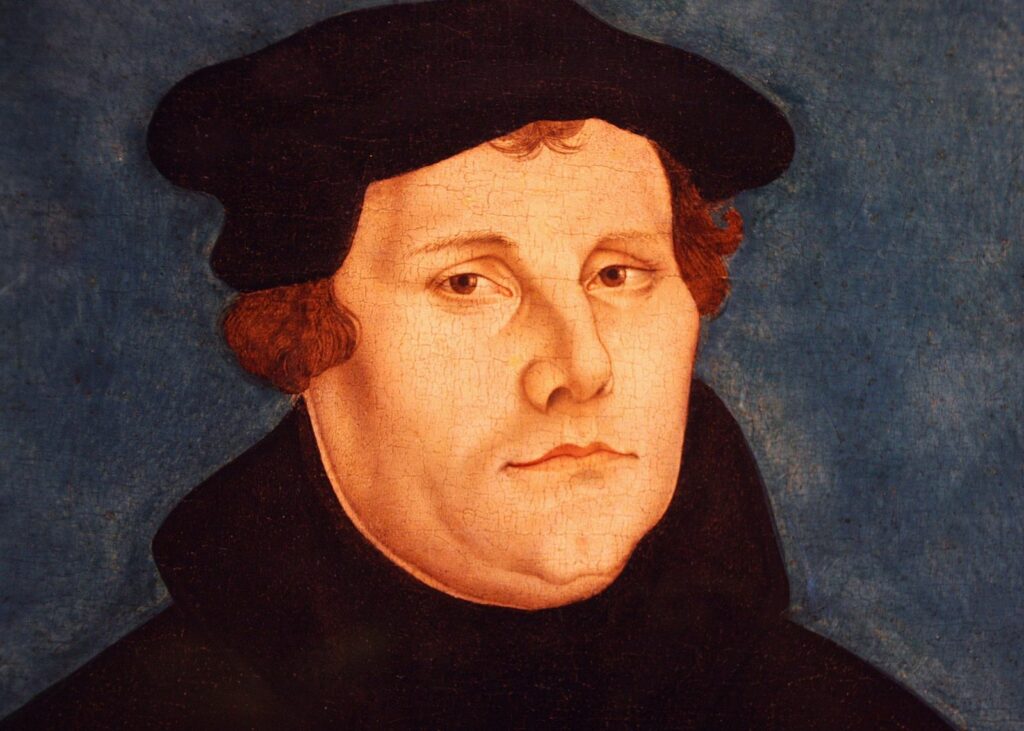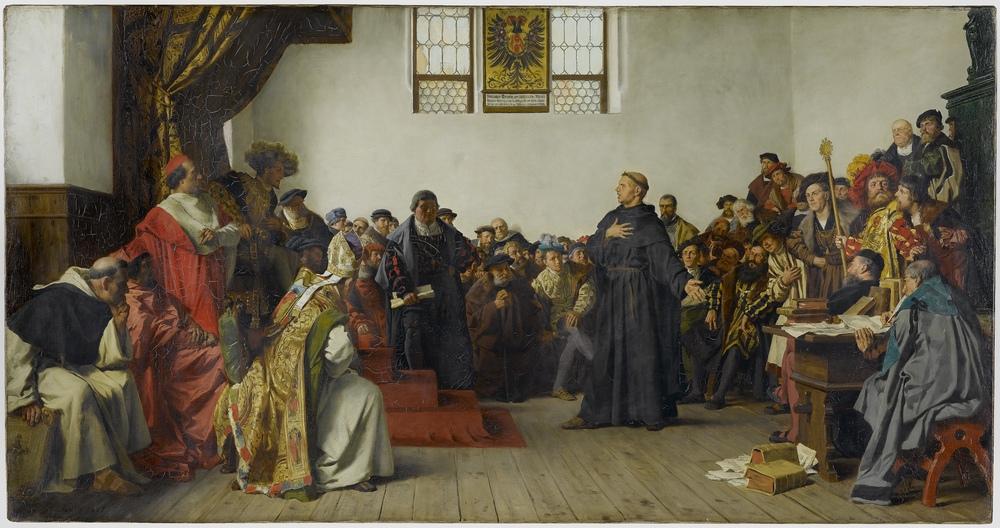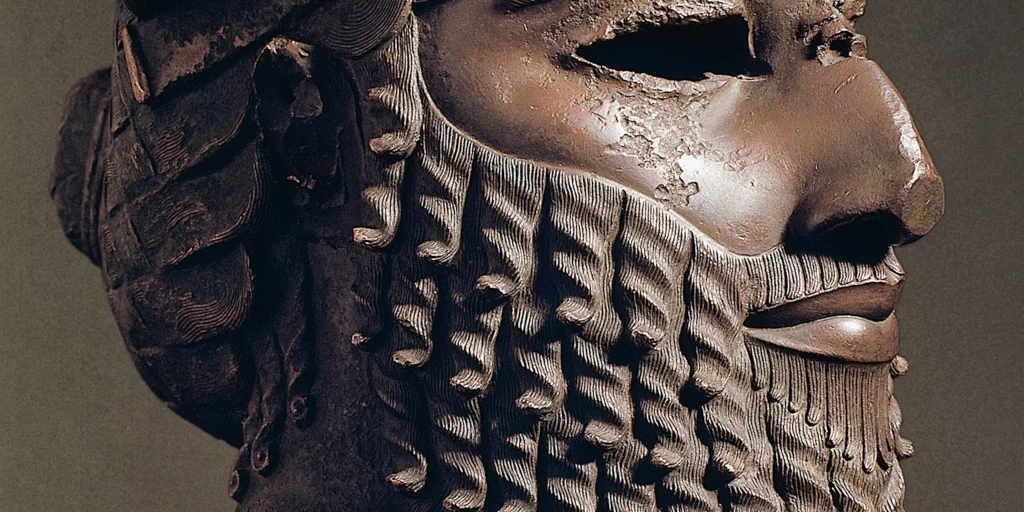No, the Diet of Worms is not a literal consumption of worms — although that wouldn’t be too bad since they are a great source of protein and macronutrients! The Diet of Worms was actually an assembly of Catholic leaders in 1521 to discuss the unorthodox opinions of Martin Luther, a German religious leader.
The event essentially gave birth to Lutheranism and strengthened the cause of Protestantism. But to understand the Diet of Worms, we need to start with the main character of the story: Martin Luther.

Who Was Martin Luther?
Martin Luther was a multi-hyphenated German born in the Holy Roman Empire on November 10, 1483. He was an Augustinian friar, theologian, author, professor, and hymn writer.
Luther was the eldest child of Hans and Margarethe Luder (later spelled Luther). Hans was a copper businessman (and later a town councilor) with many ambitions for his eldest son. Luther supposedly had many siblings, but only one can be officially found on record: Jacob.
As mentioned, Hans had high hopes for Luther — he wanted him to become a lawyer.
Luther was educated in trivium–grammar, logic, and rhetoric and graduated from the University of Erfurt in 1505 with a master’s degree. He was an obedient son and enrolled in law school after that but dropped out within a short period- to become a monk.
Why the change of heart? It is believed that he was always more drawn towards philosophy and theology.
But you know how people say they had a life-changing experience? For Luther, it was a terrifying thunderstorm that made him exchange law books for vestments and a pulpit. He was accepted in the Augustinian order in 1506 and celebrated his first mass a year later.
Luther also studied theology and received his doctorate in 1512. He joined the theological faculty of the University of Wittenberg in the same year.
While teaching at Wittenburg, Luther was also concurrent provincial vicar of Saxony and Thuringia starting in 1515, with 11 monasteries under his guidance. It was around that time that he wrote his 95 Theses.
The Birth of the Roman Catholic Opposition
The Roman Catholic Church has always been a powerful organization. This was not just because of its immense wealth, but because, back then, people essentially thought that by going against the Catholic Church, they were going against God. A fear the Catholic Church encouraged!
Those who opposed the Church bit their tongues for fear of being branded a heretic and sentenced to death. Luther became an enemy of the Church for calling out the sale of indulgences, which the Catholic faithful commonly purchase to absolve them of their sins.
Indulgence for Sale
As per Catholic teachings, you get a punishment for sinning. But these sins can be forgiven through confession, prayers, and indulgences. Indulgence is a way to reduce your punishment. It could be in the form of a specific prayer or action.
But in the Middle Ages, Catholic priests started selling indulgences to raise money. Dominican friar Johann Tetzel was the grand commissioner for indulgences in Germany. Mainz Archbishop Albrecht von Brandenburg appointed Tetzel to the position and demanded half of the sale of the indulgences to pay for his many benefices.
Luther was against the practice and made it known through his letter to Von Brandenburg. Enclosed in the letter was the famous– or infamous, depending on who you ask– 95 Theses or Disputation on the Power and Efficacy of Indulgences.
What Was Written in the ‘95 Theses’?
As the title implied, the theses contained 95 statements against indulgences. The theses weren’t direct callouts to the Catholic Church but were meant to be academic teachings about the efficacy of indulgences and how they affect poor people.
The first thesis stated, “When our Lord and Master Jesus Christ said, ‘Repent,’ he willed the entire life of believers to be one of repentance.”
The second thesis also supported this sentiment that faith would lead to salvation and not deeds, which is exactly what indulgences were. The rest of the 93 theses were all versions of why indulgences were not the best Catholic practice.
In a way, Luther had a point. For example, St. Peter’s Basilica in Vatican City, which took 120 years (1506-1620) to complete, was built through indulgences.
“Why does not the pope, whose wealth today is greater than the wealth of the richest Crassus, build the basilica of St. Peter with his own money rather than with the money of poor believers?” Luther asked.
Luther also shared this question and his theses during sermons and posted them on the church doors in Wittenburg. Between 1517 and 1521, the theses became hot discussion topics among the clergy and had already been translated into several languages.
The Church, of course, got wind of Luther’s theses, and Pope Leo X condemned them as going against Church teachings. In fact, Luther’s theses rankled the Catholic Church so much that they prompted the Diet of Worms in 1521.
The Diet of Worms
Pope Leo X issued the Papal Bull Exsurge Domine in June 1520, outlining 41 of Luther’s supposed errors in his theses.
“The treasures of the Church, from which the pope grants indulgences, are not the merits of Christ and of the saints,” read error #17 out of 41 errors enumerated in the Exsurge Domine.
“We condemn, reprobate, and reject completely each of these theses or errors as either heretical, scandalous, false, offensive to pious ears or seductive of simple minds, and against Catholic truth,” the Papal Bull also read.

As a puppet of the Church, Charles V, the Holy Roman Emperor, was pressurized to convene the Diet of Worms. Diet refers to the assembly of the Holy Roman Empire, while Worms (pronounced Verms) is a city in Germany where the assembly was held.
Luther was understandably hesitant to appear because the last time a priest was summoned by a council of Catholic leaders, he was executed. Jan Hus was a Czech priest who tried to reform the Catholic Church. Hus was called by the Council of Constance in 1415 for his dissenting views of Catholicism. He was arrested and burned at the stake for heresy in the same year.
Prince Frederick III, Elector of Saxony, promised Luther safe passage. On January 23, 1521, the Diet of the Worms commenced with the planned endgame to have Luther recant his 95 theses.
The theologian appeared before the council on April 16, 1521, but refused to recant his theses. He was then charged as a “notorious heretic.”
The Edict of Worms read in part: “We want him to be apprehended and punished as a notorious heretic.” The edict also noted that anyone who provided Luther shelter and protection would be punished.
Luther had become an outlaw, but Prince Frederick III was a man of his word and provided the theologian protection and a home. The Prince brought Luther to his castle in Wartburg, where Luther spent his years in hiding, translating the New Testament into German.
Luther continued to write and teach his beliefs, many of which were against Catholic dogma. His teachings were the basis for Lutheranism, a major branch of Protestantism, although Luther preferred the title evangelical. Luther and his followers eventually settled on Evangelical Lutheran, but modern communities go by Lutheran.
Over time, Luther and his teachings gained a huge following. Today, some 80 million people are Lutherans, the third largest Protestant sect.
Significance of the Diet of Worms
Luther was not the first to criticize Catholic dogma, but he did get the momentum going. He is often referred to as the father of Protestantism.
The Diet of Worms provided a louder voice for the Protestants, although the term wasn’t used yet then. Luther’s followers multiplied after he was declared a criminal. Lutheranism spread to Denmark, Estonia, Finland, Iceland, Latvia, Norway, and Sweden.
The term ‘Protestant’ was first used during the first Diet at Speyer in 1526. Six princes and 14 imperial cities petitioned the Diet against the Holy Roman Empire’s imperial ban on Martin Luther. The group also asked that Luther’s works be allowed to spread.
The Protestants were the following:
- Prince Ernest I, the Confessor of Brunswick-Luneburg
- Prince Francis, the Duke of Brunswick-Luneburg
- Prince George the Pious of Hohenzollern
- Prince John the Steadfast of Wettin
- Prince Philip I, the Magnanimous
- Prince Wolfgang of Ascania
- The 14 Imperial Free Cities
They formally submitted a Letter of Protestation during the second Diet at Speyer in 1529, but the convention refused to read it. This incident is considered the birth of Protestantism.
Conclusion
Catholicism has always been criticized for the power and money that the leaders hold. For centuries, people only whispered about it for fear of being punished.
But Martin Luther was brave enough to criticize some Catholic practices through his 95 Theses. When Church leaders called Luther a heretic, he only persevered to continue his teachings, which gave birth to Lutheranism and Protestantism.

